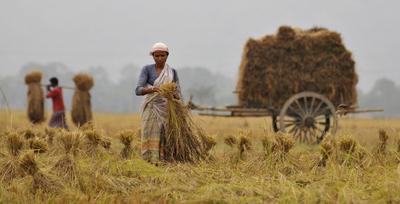Higher procurement prices were set in the 1970s, when the Green Revolution commenced, to incentivise Indian farmers to adopt new farming techniques. The distinction between procurement and support prices was given up.
In the eighties, the rate of increase was kept low to share productivity gains with consumers. In the nineties, as productivity growth slowed and devaluation widened the gap between domestic and border prices, price increases became more rapid.
Border prices became a focal point for the farmers’ lobby. Although agricultural liberalisation was always a halting process, what it did mean was that there was a closer link between farm prices and border prices. Agricultural exports, especially meat, dairy, rice, vegetables and fruits, sugar, animal feeds and vegetable oils, grew from $4 billion when the reforms began, to $17 billion in 2008-09. Import growth was around one-quarter of these values.
Even so, food grain exports were restricted, so farmers could argue they were discriminated against in order to feed the urban consumer.
Whenever border prices exceeded domestic prices there was pressure to raise domestic procurement prices; but a fall was never acceptable. The pattern in procurement prices, food stocks, and domestic inflation followed. Wheat price inflation was high in periods of currency depreciation.
Excess food grain stocks in 2001 coincided with a slump in world food prices, and appreciation of the rupee. Some stocks were exported at a loss. Although Indian prices rose less than international prices they did not fall when international prices fell.
Stocks built up again even as domestic food inflation continued in double digits. Steep depreciation and volatility of the rupee contributed to price pressures.
The Government was unable to sell its stocks since cost price exceeded the market price. It was feared that if stocks were given away they would just be sold back to the Government.
The Government became the biggest food grain hoarder, helping keep prices high. Policies meant to help resulted in high cost storage and wastage of grain. Subsidies substituted for investment in agriculture, reducing productivity. Farmers’ misery increased.
Populous developing East Asian countries moderated food inflation and focused on raising agricultural productivity when food budget shares were high.
Prices were allowed to rise only after food budget shares fell; prices could then rise without pressure on wages and inflation. Governments could turn from taxing to subsidising agriculture as the sector shrank.
India moved to subsidising agriculture, together with implicit taxes from restrictions, when food budget shares were still high.
But raising nominal farm prices does not guarantee favourable terms of trade for farmers, as nominal wages, industrial prices and input costs also rise after some lag.
Since the income elasticity of demand for food is still high, more moderate nominal price increases provide better agricultural output and income growth, as they did in the eighties. Stable prices may actually provide better incentives for farmers.
If the procurement price of food grain becomes a true support price, food stocks fall in a bad agricultural season when market prices rise, and rise as market prices fall in a good year. Farmers would get some assured income support, even as more genuine liberalisation and better infrastructure allowed them to diversify crops.
Food grains, for which the elaborate food policy structure is designed, now account for only 25 per cent of agricultural output. Thorough supply-side reform is required.
Political jostling focuses on the short-term, ignoring negative long-term effects. Poor coordination means multiple agencies do not factor in each other’s costs, or consider the big picture. Since border prices act as a trigger for these interest groups, a change in the nominal exchange rate can abort the whole process.
Since exchange rates affect many agricultural prices, apart from food grains, exchange rate adjustment is an effective response to temporary external or internal price shocks in an open economy.
Ashima Goyal is professor of economics in the Indira Gandhi Institute of Development Research in Mumbai.
An earlier version of this essay appeared in Business Line, India.

